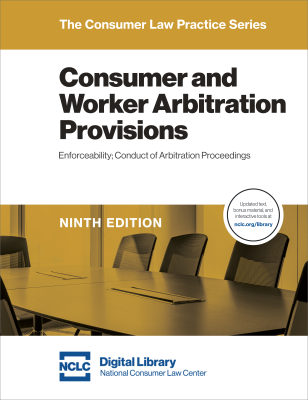Corporations Hate Class Arbitration Even More than Class Actions
A primary reason for the pervasive use of arbitration requirements in consumer transactions is corporate attempts to evade class action exposure. Many arbitration agreements prohibit not only class actions, but also class arbitration, and the Supreme Court has previously upheld such prohibitions. See American Express Co. v. Italian Colors Restaurant, 570 U.S. 228 (2013); AT&T Mobility, L.L.C. v. Concepcion, 563 U.S. 333 (2011).
Such bans on class arbitration are not surprising because corporations often fear class arbitration more than they do class actions in court—less judicial review, speedier process, and arbitrators are paid by the hour. Consumers are in a strong position if they can proceed in arbitration on a class basis, which may turn the tables on corporations using mandatory arbitration to avoid liability for their law violations. While many arbitration agreements prohibit class arbitration explicitly, often consumers are presented with an agreement that contains no such ban.
Lamps Plus Narrows but Does Not Eliminate Opportunities for Class Arbitration
While class arbitration is not possible if the arbitration agreement explicitly prohibits it, class arbitration can proceed if the agreement does not have an explicit ban and instead is interpreted as allowing such a procedure. The Supreme Court’s April 24 decision in Lamps Plus, Inc. v. Varela, 2019 WL 1780275 (U.S. Apr. 24, 2019) just made it harder to interpret an agreement as allowing class arbitration, but does not foreclose such an interpretation.
The Ninth Circuit in Varela v. Lamps Plus, Inc., 701 Fed. Appx. 670 (9th Cir. Aug. 3, 2017), found that the arbitration agreement was ambiguous as to whether it allowed class arbitration. Because ambiguous contracts are to be interpreted against the drafter, a doctrine enshrined in contract law in all 50 states, called contra proferentem, the Ninth Circuit allowed class arbitration. The Supreme Court with the usual 5-4 split found in most of its arbitration decisions, reversed because contra proferentem was an insufficient basis to determine whether the parties intended to allow class arbitration.
In Stolt-Nielsen S.A. v. AnimalFeeds Int’l Corp., 559 U.S. 662 (2010), the Court had already ruled that where an arbitration clause is silent about the availability of class arbitration, its availability cannot be based upon public policy considerations, but must be based instead upon something in the contract indicating the parties’ intent. Lamps Plus goes one step further and finds that where the parties’ intent is ambiguous, the doctrine of contra proferentem is an insufficient basis to determine the parties’ intent.
The Court enunciated its clearest preference yet against class arbitration, and found that there must be an affirmative contractual basis for concluding that the parties agreed to allow class arbitration. According to the majority, the policy doctrine of contra proferentem is not such a contractual basis.
On the other hand, the decision is clear that arbitration is strictly a matter of consent and that if the parties’ intent in an agreement is to consent to allow class arbitration, then class arbitration should be allowed. Lamps Plus quotes Granite Rock Co. v. Teamsters, 561 U.S. 287 (2010): “The first principle that underscores all our arbitration decisions” is that “arbitration is strictly a matter of consent.”
Justice Kagan Shows a Path to Follow Now in Arguing for Class Arbitration
The majority decision in Lamps Plus is based upon the Ninth Circuit ruling that the arbitration agreement in that case is ambiguous as to the availability of class arbitration. Not addressed is what happens where there is a finding that the agreement unambiguously allows class arbitration. No arbitration agreement in consumer transactions is going to explicitly state that class arbitration is allowed, but standardized language found in some arbitration agreements can still be interpreted as unambiguously allowing such a procedure. If the intent is unambiguous, even the majority holding would allow class arbitration.
Justice Kagan’s dissent persuasively quotes language in the Lamps Plus arbitration agreement as showing that the Ninth Circuit got it wrong, that language in the arbitration agreement shows an unambiguous intent to allow class arbitration. Justice Kagan points to the following language found in the agreement:
- “[T]he parties agree that any and all disputes, claims or controversies ... shall be resolved by final and binding arbitration.”
- “Arbitration shall be in lieu of any and all lawsuits or other civil proceedings relating to my employment.”
- The arbitrator may “award any remedy allowed by applicable law.”
Justice Kagan also debunks the argument that the agreement’s use of the singular in describing each of the parties to the agreement indicates the agreement’s intent to bar class arbitration. Instead, the use of the singular indicates that the agreement is bilateral in nature, but does not determine whether one of those two parties can raise claims on a class basis.
Does the Arbitrator or Court Construe the Parties’ Intent As to Class Arbitration?
As indicated by Justice Kagan’s dissent, short of explicit language banning or allowing class arbitration, determining the parties’ intent is often in the eye of the beholder. Justice Kagan found the language unambiguous while the Ninth Circuit found it ambiguous.
A critical issue then is who decides the parties’ intent—the arbitrator or a court. The Supreme Court in Lamps Plus indicates that the Court is not resolving (and has yet to resolve) whether the availability of class arbitration is a gateway issue for the court to determine or is an issue for the arbitrator to decide (see Lamps Plus, note 4). In Lamps Plus the parties had agreed that the court would make that determination, but the Court takes no view on who should presumptively make that determination absent an agreement between the parties delegating the issue to the arbitrator to decide.
The weight of authority presently favors the court deciding the issue of whether class arbitration is to be allowed. But even courts that view the question as one for the court come to a different conclusion when the arbitration agreement contains a “delegation” clause delegating questions of arbitrability to the arbitrator. In that case courts are likely to rule that the arbitrator will interpret the agreement to determine if it allows class arbitration.
Nevertheless, not all courts treat a delegation clause as delegating the question of class arbitration the way they would delegate other issues of an arbitration clause’s scope or enforceability. The law on delegation and class arbitration varies from circuit to circuit, with some courts requiring “a more particular delegation of the issue [of class arbitration] than we may otherwise deem sufficient in bilateral disputes.” Catamaran Corp. v. Towncrest Pharmacy, 864 F.3d 966, 973 (8th Cir. 2017). But see Dish Network L.L.C. v. Ray, 900 F.3d 1240, 1247 (10th Cir. 2018) (rejecting heightened standard for delegating class arbitration, and holding that incorporation of AAA rules sufficed to give class arbitration question to the arbitrator). See generally NCLC’s Consumer Arbitration Agreements § 9.2.1.
Delegation clauses are increasingly utilized in arbitration agreements because they make it that much more difficult for consumers to challenge in court an arbitration requirement’s enforceability. The Supreme Court has ruled that the presence of such a delegation clause makes the question of arbitrability one for the arbitrator. See Rent-A-Center, West, Inc. v Jackson, 561 U.S. 63 (2010). Thus in many contracts that do not explicitly ban class arbitration, but where a delegation clause is found, it will be an arbitrator who decides whether a class arbitration is to be allowed.
Experience shows that arbitrators often interpret agreements as allowing class arbitration. While corporations select arbitration forums where they believe that the forum will provide favorable arbitrators, arbitrators are paid by the hour and will not shy away from the added work of a class arbitration.
Supreme Court: Arbitrator's Construction of Contract As Allowing Class Arbitration Should Almost Always Stand
In Oxford Health Plans L.L.C. v. Sutter, 569 U.S. 564 (2013), the Supreme Court ruled that when the arbitrator interprets the parties’ intent in an arbitration agreement as allowing for class arbitration, then “courts may vacate an arbitrator’s decision only in very unusual circumstances.” As long as the arbitrator “(even arguably) interpreted the parties’ contract” the arbitrator’s interpretation should not be disturbed.
Consequently, where an arbitration agreement does not explicitly ban class arbitration, but where the agreement contains a delegation clause, then the determination of the parties’ intent as to class arbitration will normally be for the arbitrator. The courts will then almost never disturb an arbitrator’s interpretation allowing class arbitration.
One Caveat About Chief Justice Roberts and the Majority
While the above analysis indicates that Lamps Plus still allows some room for class arbitration, it is likely that the next time questions of class arbitration come before the Court, that the opportunity for this procedure will be further narrowed. Chief Justice Robert’s majority decision admits to a clear animus as to class arbitration, only counterbalanced by the cardinal rule that courts should allow the parties to form their own agreements.
That decision views class arbitration as not possessing the benefits of individual arbitration. The Chief Justice finds it slower, more costly, and more likely to generate a procedural morass. (While this may be true when one class arbitration proceeding is compared to one individual arbitration proceeding, it can hardly be said the same when compared to the thousands of individual arbitrations that would be needed to replace the one class arbitration.)
Justice Roberts also was concerned that class arbitration introduces new risks and costs for both sides (although this can hardly be a concern for the consumer who is voluntarily deciding to proceed with the case on a class basis). That is, the corporation forcing the consumer into arbitration to avoid exposure to class action liability may find it did not succeed and faces the same exposure, only with more limited judicial review.
Finally, the decision indicates that class arbitration raises due process concerns for absent class members. There is thus a risk that a class arbitration providing only minimal benefits to the class in return for a release of claims may find itself eventually before the Supreme Court, and the Court may strike the decision down on due process concerns.
The Alternative to Class Arbitration
While class arbitration has some continuing viability, another often more promising avenue is to challenge the enforceability of the arbitration agreement on other grounds, allowing the case to then proceed in court on a class basis. Such challenges to the enforceability of an arbitration agreement are detailed in NCLC’s Consumer Arbitration Agreements.


